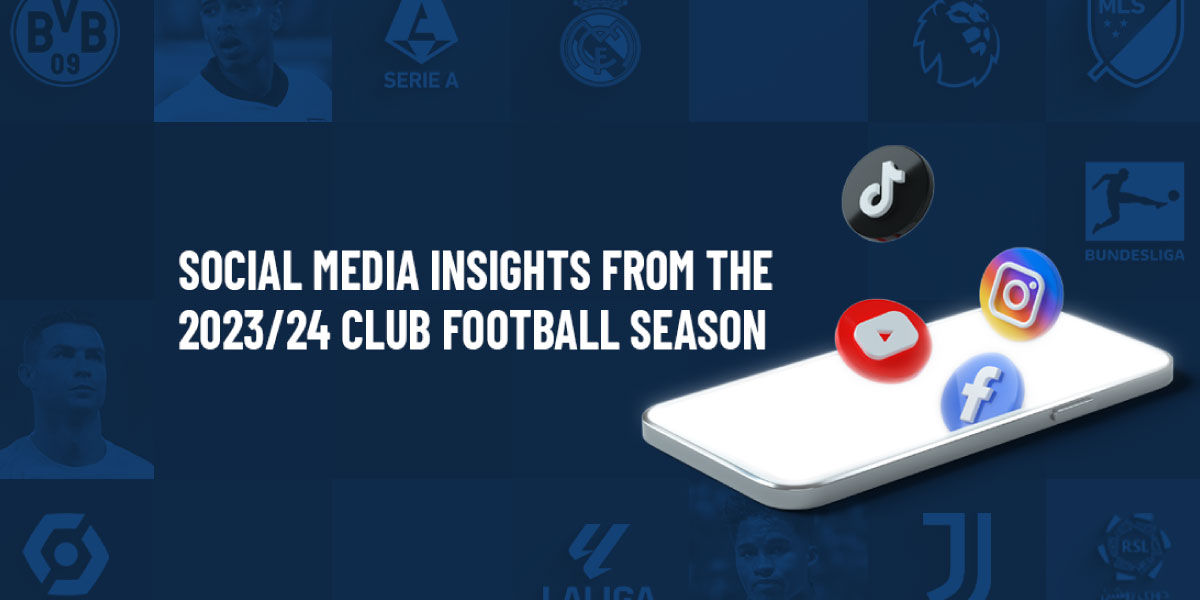The 2023/24 club football season introduced a wealth of impressive performances. While our previous article examined these from a business perspective, this analysis delves into the social media performance of leagues, clubs, and players during the same period, uncovering some captivating trends.
Follower growth slows in Europe, but speeds up in Saudi Arabia and the USA
International football leagues have strategically focused on three key platforms to drive their social media growth throughout the season. Alongside Instagram, which remains essential in the football world, significant follower growth was observed on TikTok and YouTube for the European “Big Five” leagues. Unsurprisingly, these video-centric platforms have risen to prominence in football as well, aligning with evolving consumer habits.
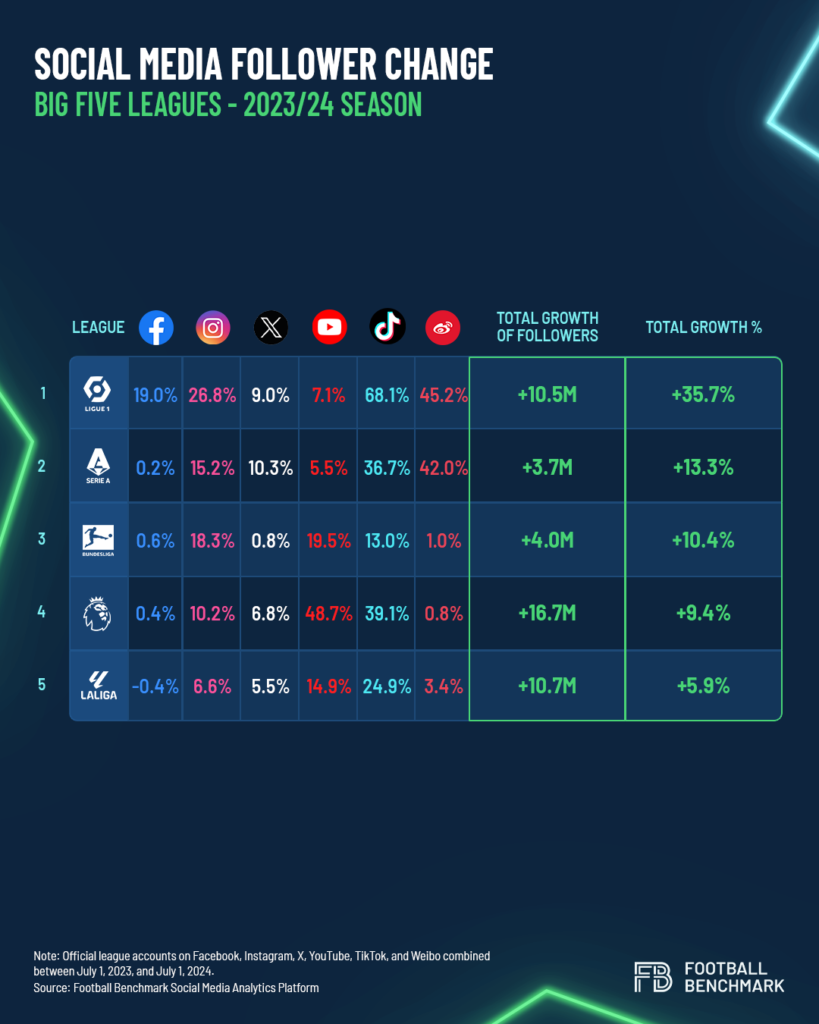
The top five European football leagues experienced a slowdown in social media follower growth rates compared to the previous season. In the 2022/23 season, LaLiga saw a substantial growth of 28.8%, which dropped significantly to 5.9% in 2023/24. Similarly, the English Premier League’s growth decreased from 20.2% in 2022/23 to 9.4% in 2023/24.
Among these leagues, Ligue 1 emerged as the best performer, achieving a robust 35.7% growth in 2023/24, following an impressive 47.8% in the previous season. Much of Ligue 1’s new follower base came from TikTok, highlighting the platform’s growing influence in sports marketing and fan engagement.
When analyzing social media strategies, it is notable that two leagues significantly strengthened their presence on the Chinese Weibo platform – Serie A and Ligue 1 – while the German Bundesliga, the English Premier League, and LaLiga focused on YouTube and TikTok prominently.

Outside the “Big Five” European leagues, the most spectacular follower growth occurred in Saudi Arabia and in the USA, driven by global superstars Cristiano Ronaldo and Lionel Messi, along with other high-profile players who also joined these leagues.
The surge in interest in the Saudi Professional League is evident from its follower growth, which nearly matched that of the German Bundesliga and Serie A: the Saudi top league gained 3.6 million new followers during the period under review, compared to Serie A’s 3.7 million and the Bundesliga’s 4 million. Major League Soccer (MLS) gained 5.9 million new followers during the analyzed period, surpassing the follower growth of two of Europe’s “Big Five” leagues.
Strategic focus on video content: leveraging TikTok and YouTube
The same trend observed in leagues is also noticeable among clubs: YouTube and TikTok have been the primary channels where clubs have gained the highest number of new followers, focusing their growth strategies accordingly.
Among the top 20 clubs that gained the most followers during the season, seven are from LaLiga, five from the English Premier League, and three from the Saudi Professional League. Interestingly, despite LaLiga teams significantly increasing their follower base, the league’s overall follower growth lagged behind previous years.

In terms of percentage growth in follower numbers among the top 20 examined clubs, Spanish and Saudi clubs stand out prominently. Al-Ahli Saudi FC achieved an impressive +179%, and Cádiz CF followed with +125%. Other notable clubs include Inter Miami CF, Real Sociedad de Fútbol, Real Betis Balompié, Sevilla FC, Al-Nassr FC, and Al-Hilal SFC. On the other end of the spectrum, top clubs like FC Barcelona (+4%), Manchester United FC (+4%), and FC Bayern München (+6%) saw only minimal increases in their follower base during the season, although as they are among the global leaders in this field, high percentage increases will always be difficult for them.
Real Madrid CF, which gained the most new followers (+45.1M), also lead the total engagement list by a wide margin. Throughout the season, their content on Facebook, Instagram, TikTok, and X generated 2,418 million engagements.
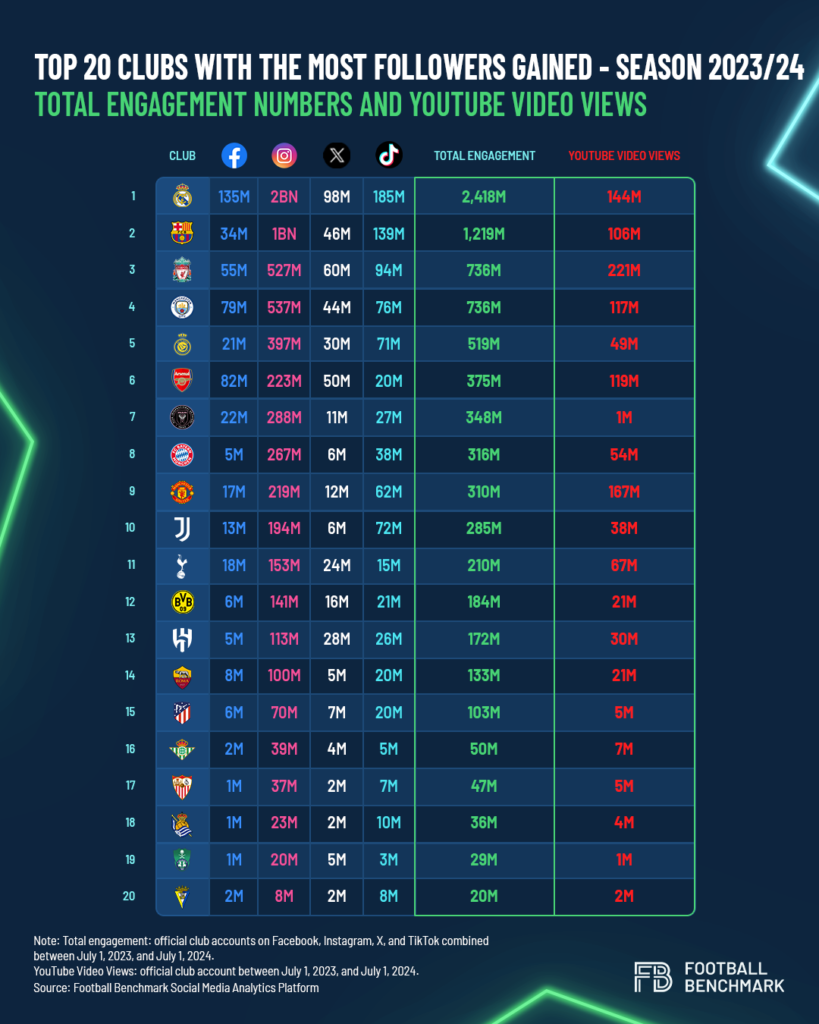
The global fan communities of the two Spanish giants, Real Madrid and Barcelona, are incredibly active. However, Liverpool FC and Manchester City FC’s fan bases also demonstrated notable engagement throughout the season. Outside the top 20 clubs examined, Chelsea FC (410M), Galatasaray SK (305M), FC Internazionale Milano (195M), AC Milan (192M), SL Benfica (82M), and Bayer 04 Leverkusen (77M) also showed outstanding activity.
Regarding YouTube video views, Liverpool lead the pack with 221 million views on their channel during the period under review. In addition to match highlights, the resignation of the club’s legendary coach, Jürgen Klopp, drove significant traffic to their channel. Following Liverpool on this list are Manchester United, Real Madrid, Arsenal, Manchester City, and FC Barcelona, all of which surpassed 100 million views during the season.
Real Madrid’s social media dominance – impact on player’s follower numbers
Real Madrid boast the largest social media following globally among football clubs, and indeed across all sports clubs. Therefore, it’s unsurprising that this also has a significant impact on the number of followers for the club’s players.
When examining the follower growth of players in Europe’s top five leagues and beyond, one trend immediately stands out: the exceptional performance of Real Madrid players and future recruits in this area.
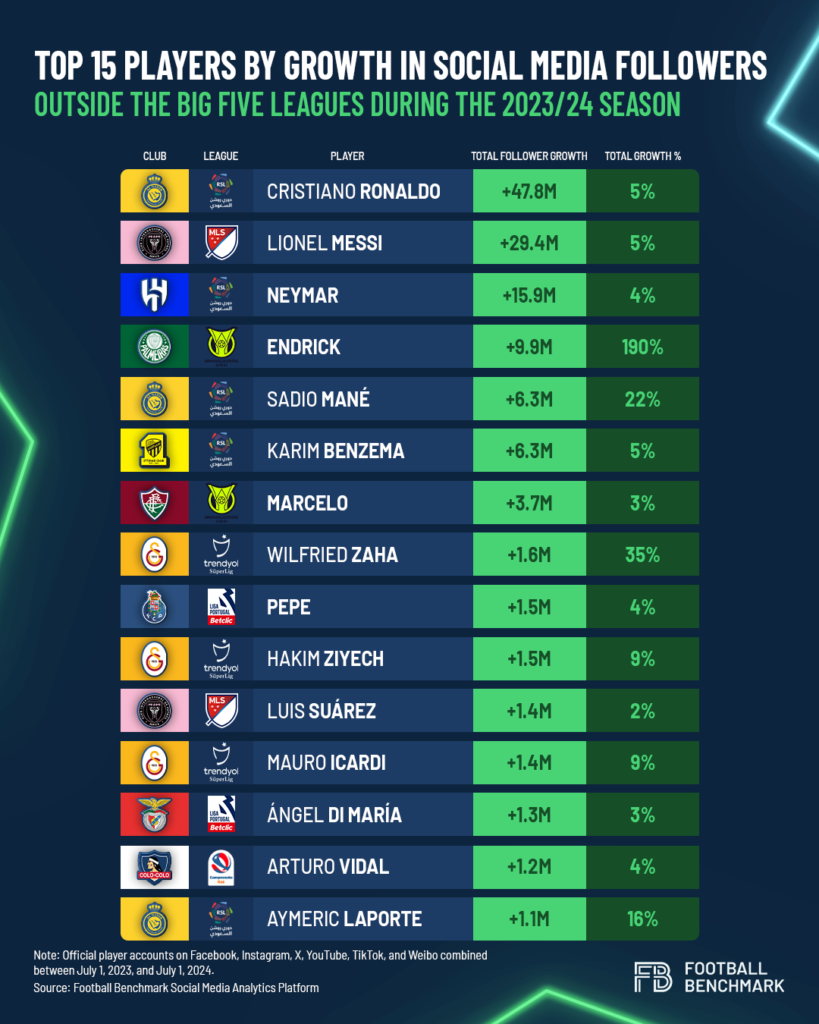
Of the 15 players on the list, 10 were with Real Madrid during the 2023/24 season. Adding Kylian Mbappé, who will join the Spanish giant next season, and Sergio Ramos, a legend of “Los Blancos”, brings the total to 12 players linked to the club. The most spectacular percentage growth in followers was seen with French international Aurélien Tchouaméni, European Golden Boy winner Jude Bellingham, and former Manchester City player Brahim Díaz.
The activity and strength of Real Madrid’s community are further highlighted by the significant growth in the follower base of Endrick, who has seen a surge in followers since the announcement of his transfer to the club.
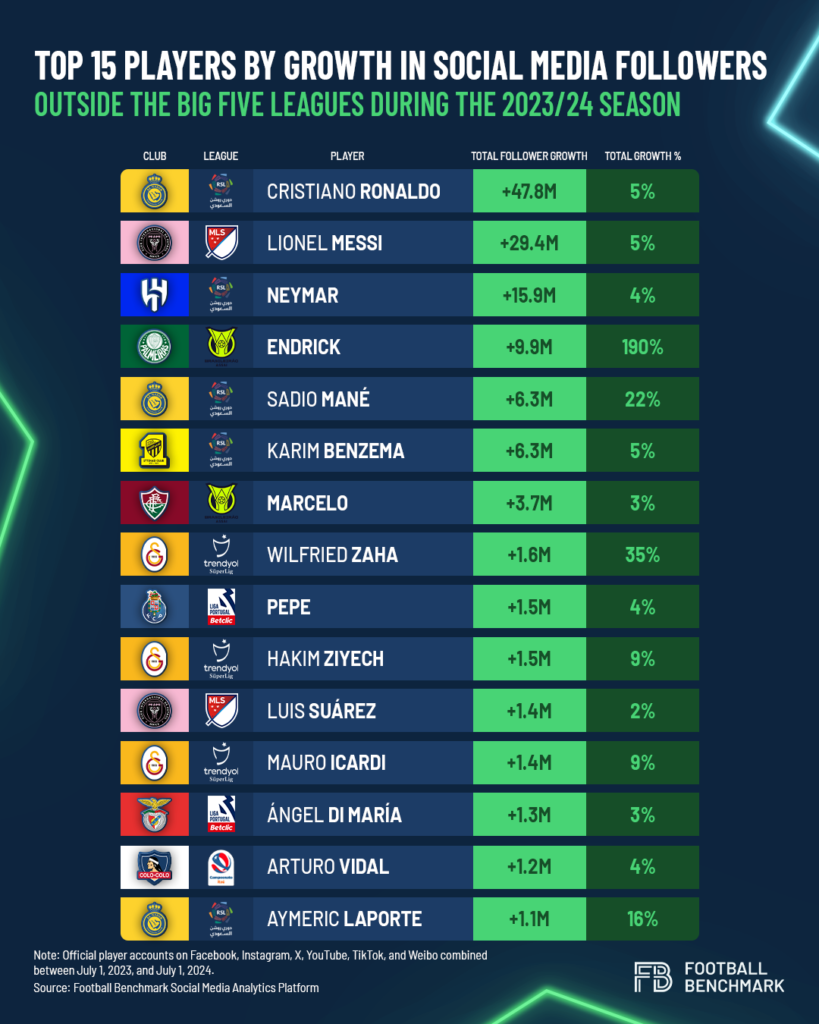
In our analysis of player follower growth outside the “Big Five” leagues, it’s striking that five players hail from the Saudi Professional League. This trend underscores the increasing attention and support these players are receiving from fans of Saudi clubs.
In conclusion, the 2023/24 club football season not only showcased impressive on-field performances but also highlighted notable shifts in social media engagement across leagues, clubs, and players. MLS’s surpassing of several members of Europe’s “Big Five” in follower growth, along with Saudi clubs outperforming top European counterparts, underscores the evolving dynamics within football’s digital landscape.
This article was produced by Football Benchmark.
SHL: Social media insights from the 2023/24 club football season
The 2023/24 club football season introduced a wealth of impressive performances. While our previous article examined these from a business perspective, this analysis delves into the social media performance of leagues, clubs, and players during the same period, uncovering some captivating trends. Follower growth slows in Europe, but speeds up in Saudi Arabia and the USA International football leagues have strategically focused on three key platforms to drive their social media growth throughout the season. Alongside Instagram, which remains essential in the



